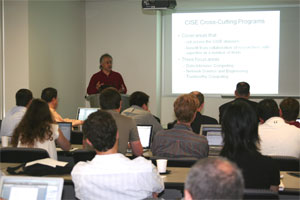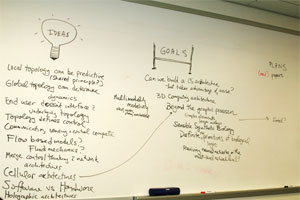Finding Common Ground in Diverse Research
|
Irvine, Calif., July 8, 2009 -- Biology has outgrown the lab. No longer can biologists and biomedical researchers find all their answers in microscopes and Petri dishes. Researchers must catalogue and analyze reams of data, relying on mathematical simulations to detect patterns and derive optimal outcomes.
Computer science provides a helping hand, allowing scientists to glean answers quickly and more efficiently.
And biology returns the favor. Many biological principles hold the answers to problems in computer science – information transport, feedback control and scaling, for example.
About 50 computer scientists, engineers and biologists spent a recent day at Calit2 discussing the commonalities in their fields, looking to develop shared principles of organization and control, and seeking potential collaborations.
Arthur Lander, developmental and cell biology professor, told the group that systems biology has undergone a philosophical shift. Not only must biologists acknowledge the field’s complexities and reliance on modeling and mathematical simulations, but they must recognize that the principles of design are just as important as the mechanisms themselves.
Similarly, computer scientists must understand that biology, which has had billions of years to create its designs, can lend important information to the field of computing.
“Does biology come up with the same strategies as engineering? Often yes,” he said, citing several examples including foraging, analog-to-digital conversion and sensing mechanisms.
|
||||
Computer science professor Tatsuya Suda echoed that message. He explained that understanding such biological processes as ant routing and immune system-intruder detection is helping computer scientists create more secure computing systems.
Ender Ayanoglu, director of the Center for Pervasive Communications and Computing, specializes in improving signal processing. He said many algorithms used by engineers to solve problems in computer-aided circuit design, artificial intelligence and signal processing are also used in biological areas like gene sequencing. A lot of engineers, he said, are “taking nature and applying it to engineering to solve problems.”
After listening to presentations from several Calit2-affiliated research centers, including the Center for Complex Biological Systems, the Parallel Systems & Computer Architecture Lab, the Scientific Inference Systems Laboratory, and the Center for Pervasive Computing and Communications, the group discussed specifics over lunch. The result was an extensive list of ideas and goals.
Calit2 Irvine division director G.P. Li was pleased with the success of the workshop and enthused by the possibilities. “The event really made everyone aware of how much the computer science and engineering fields share with biology,” he said. “I’m confident that all the ideas and the new opportunities for collaboration that were identified this morning will produce enormous benefits for a lot of researchers.”



